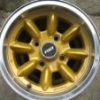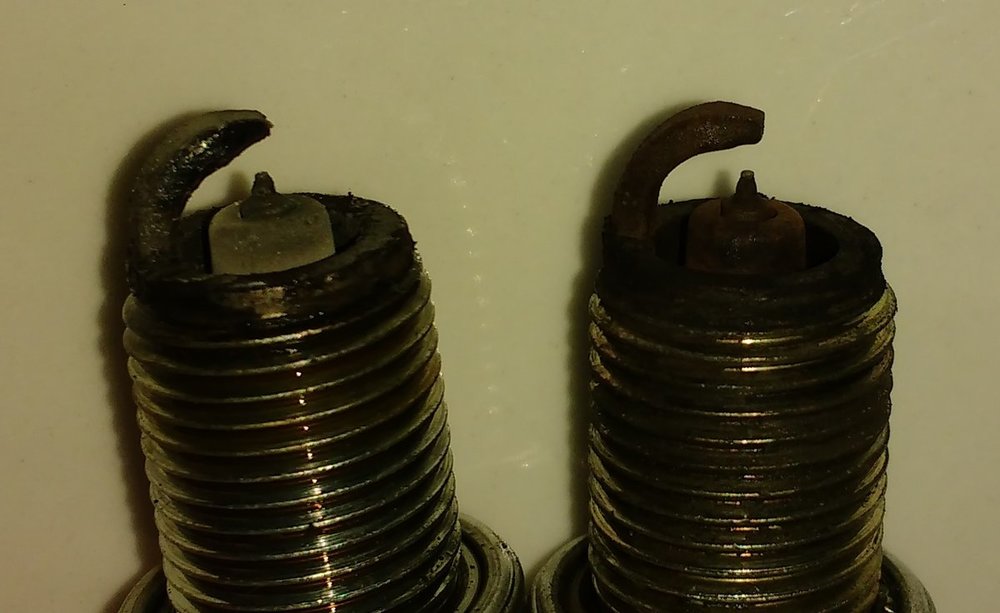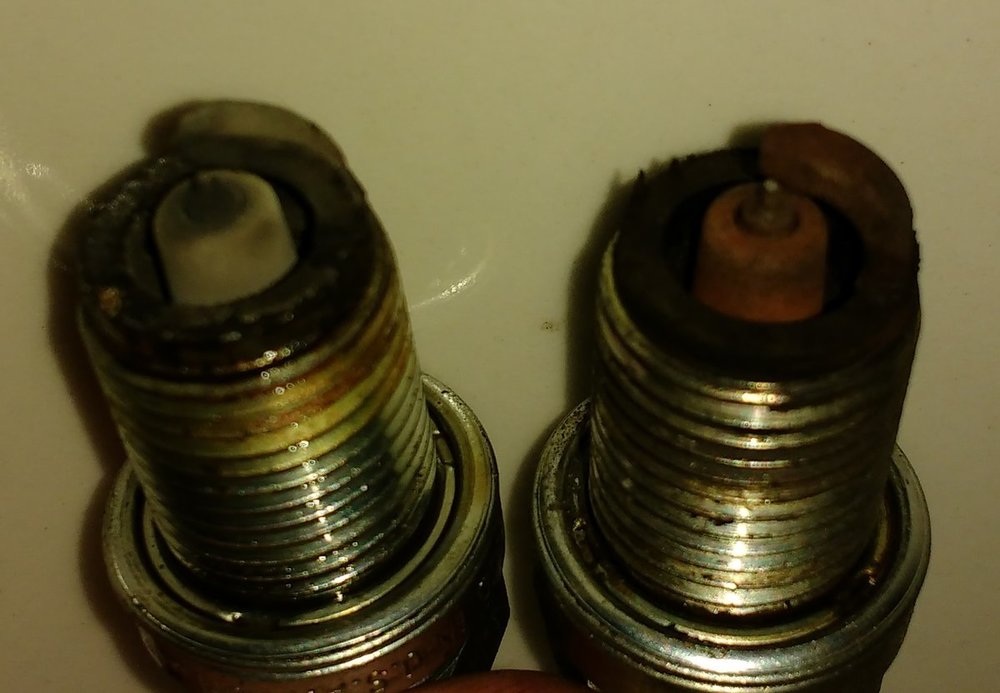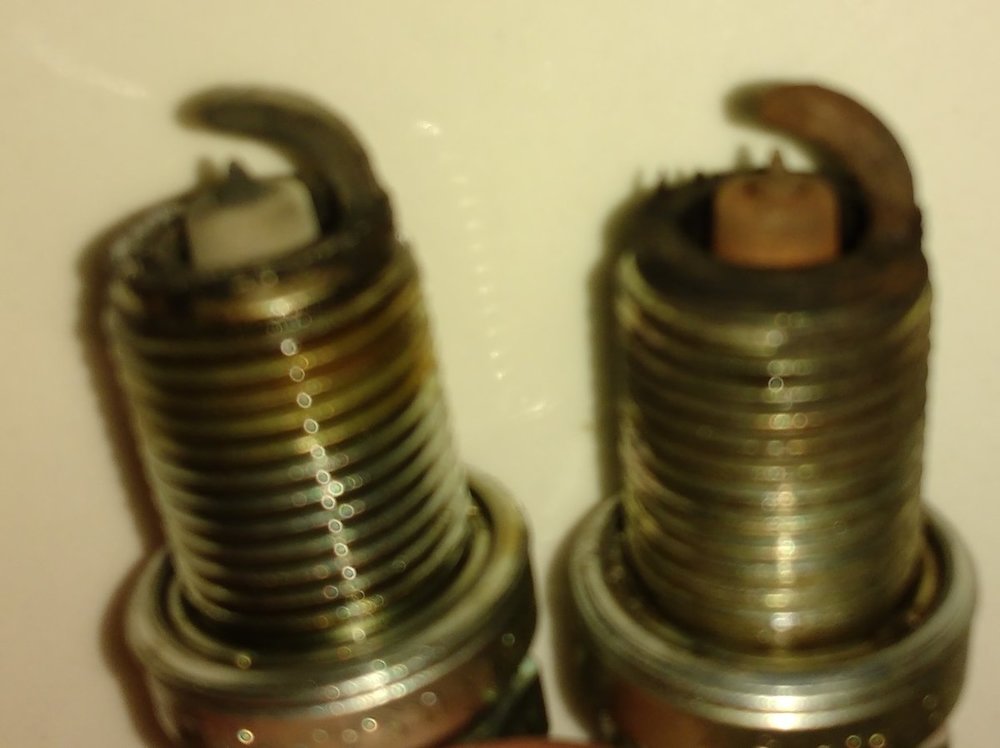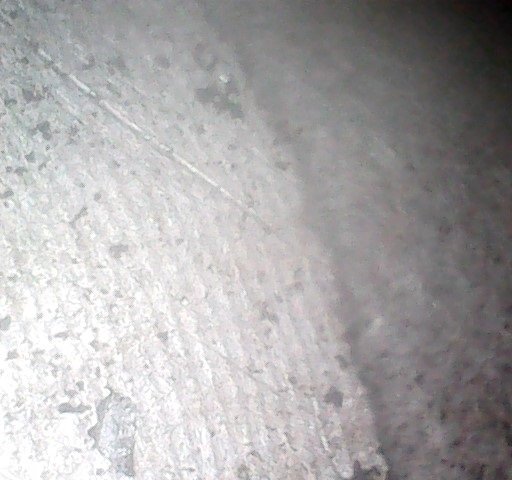Search the Community
Showing results for tags 'Head gasket'.
-
It’s kind of crazy to think how long I’ve been in the Subaru game and yet I’ve never replaced a 2.5 head gasket! I only want to deal with this repair once, hence this thread: I was under my wife’s 1999 Forester for an oil change over the weekend and noticed the bottom of the driver’s side of the engine was COVERED with engine oil. I had long suspected that it was the cam seal leaking, but the volume of oil and the area it covered has been slowly growing over the last few oil changes. A little research revealed that the EJ253 in this Forester likes to pop its head gasket and then leaks oil externally, which correlates with what I’m seeing. We lose about 1-2 quarts of oil between changes (I top it up often) but the engine doesn’t appear to burn any oil (no smoke out the tailpipe, hot or cold). The head gaskets were originally replaced at 78k miles (w/ P/N 11044AA633 head gaskets) and the engine now has about 205k miles on it now. We’re past due for a timing belt as well, so here is the list of parts that we’ve got so far: Timing Belt Parts: Timing belt Tensioner/idlers Crank pulley bolt Water pump & gasket Thermostat & gasket Cam seals F/R Crank seals A/C idler pulley Oil pump reseal/O-ring kit I’ve been doing a bunch of research on what else I should touch “while I’m in there.” In past posts @GeneralDisorder has suggested changing out the piston rings, installing knurled pistons and upgrading to a 10 mm oil pump. I will have the heads milled (if still in spec) but what else should I consider? Valvetrain work? Is there anything I can do to help oil drain back to keep the pistons from getting clogged? Head Gasket Parts: 770 head gaskets Exhaust manifold gaskets Intake manifold gaskets Valve cover gaskets Valve seals (int. & exh.) (I’ve read that the SOHC engines have a tendency to drop exhaust valve guides and that these should be knurled to keep them from dropping?) Sparkplug tube seals Valve cover bolt grommets Misc. Parts: Spark plugs Spark plug wires 10mm oil pump PCV valve Knock Sensor (original is cracked) Battery cables/tie down/j-bolts (battery terminals/tie down are fuzzy and have read this is a potential cause of driver’s side gasket failures) So, flame suit on, please let me know what you think of my parts list! Are there obvious omissions? Are there parts I could swap in for little expense that will help power/longevity (such as uprated camshafts, pistons, etc.?) Note, this isn’t a performance build, so I’m not thinking about forged, high-compression pistons or anything, but if there is an OEM piston that I could swap in that would provide a slight performance advantage, I would be interested in something like that, or Delta Cams, etc. How far away from a Frakenmotor would I be? Would an STI oil pan be something to install?
- 105 replies
-
I have 2 (two) 1997 Legacy wagons. EJ22 5MT Normally aspirated. Both took the beating a career pizza delivery guy could dish and now one at ~270,000 miles; each has a HG leak. I will soon commence the HG replacement and clutch on one. I am looking for several pieces of advice, tips, tricks and whatever input persons with experience may have... HG thickness/brand -- I see MLS in varying thicknesses from 0.040" to 0.088" available from Cometic, Six Star and Mahle. Clutch kits -- plates, flywheels brands seem to be about the same from various suppliers with the throw bearing being a crucial subaru component. Engine Hoist/ mount-- Since I will be replacing the clutch as well obviously pulling the engine is essential and makes HG replacement easier. Can I get by with a rope pulley system from the garage rafters lowered onto brick/wood support (I don't really want to be working on the engine on the ground) or should I rent/purchase engine hoist and mount? Thanks in advance- John
-
Hi all, This is a 2000 Subaru Legacy L Wagon EJ25, just recently cracked 200k miles. Replaced the valves, head gaskets, and timing belt about 5 years back when the belt snapped and crunched the valves. Replaced the spark plugs, wires, fuel pump and filter less than 2 years ago. Last week, I realized my overflow reservior was empty and that there was tons of rust colored water in my cooling system. I knew that I at LEAST needed to flush it and replace the coolant. Pretty concerned as to the source of the rust; could be the water pump impeller, lower radiator hose spring, etc. Considered just replacing the water pump out of an abundance of caution, but decided I would let it ride as long as the cooling system is working, and just flush it. Noticed rust colored residue at one side of my lower radiator hose and realized that it was leaking, but so very slowly that it didn't leave a puddle as it did so. Probably just evaporating off the hose as the car ran. Cause was a worm drive hose clamp that had come slightly loose. I think I might need to get a more reliable type of hose clamp, but just tightened it up for now. First I removed the thermostat (not rusted), then did a couple water flushes, then a 50/50 vinegar/water flush for a day, then ran water through the radiator and engine with a garden hose. That was all this last weekend. On Sunday, after flushing with the garden hose, I put a bottle of Prestone Flush + Cleaner in the system plus water. Instructions say you can drive with the cleaner in the system for up to 6 hours over the course of a few days for "heavy duty cleaning". I planned to drain and flush the system again today, when my new thermostat was scheduled to arrive, then fill up with coolant. However, this afternoon the engine started idling rough and the CEL started flashing, which I've never seen before. The engine also starts to overheat. I check the radiator and find it's missing a good half gallon, which is confusing as hell because there is no leaking under the car and no white smoke has been coming out of my tailpipe. The overflow reservoir is also completely full and bubbling when I check it. Removed the timing belt cover; no rust colored splattering as you might expect from a weeping water pump. I could see the water pump too; no signs of problems. No problems in the engine oil either as checked via the dipstick. I refilled the radiator and emptied the overflow reservoir, but the overflow reservoir keeps filling up, bubbles and all, and then I overheat again. The engine also idles rough. The CEL will flash when I am idling at a stop, but then cease to flash when I'm driving and just stay on instead. Code is P0304 - Cylinder 4 misfire. I have a sinking feeling that I may have damaged my head gaskets with this Prestone cleaner, and now have a damaged head gasket leaking coolant into cylinder 4. I've drained and flushed my cooling system again and refilled it with just water. After watching the level at the filler neck, it seems it may be very slowly draining drop by drop, with no external leakage visible, which could mean coolant is going into the engine. I am going to investigate further tomorrow morning. I used an otoscope to peer into cylinder 4 and didn't see any water or rust stains. I even tried lightly pressurizing the engine with the garden hose when I was flushing it and still didn't see any water inside. However, the cylinder 4 spark plug is reddish with black, while the cylinder 1 spark plug is white with some black deposits. I've attached 3 photos of the spark plugs as well as 1 of the inside of the cylinder 4 using the otoscope. If this problem sounds familiar, or anyone has any advice on what more tests I can do to diagnose this issue, I would much appreciate it!
-
Hello all, hope you're having a good night (or day)! My '92 Loyale has run well for the past couple months I've owned it. No overheats, no stalling and good, smooth power (for a Loyale). A couple days ago I got bored and decided to drain and replace my coolant which was brown and a little chunky. I'm very very new to auto maintenance and I don't really have anyone to tell me what's what, so I didn't recognize the brown coloration as a sign of oil-coolant mixing. Drained it all out of the radiator and flushed with water till it came out clear, filled it up with new coolant and bubbled it for about 30 mins just like the YouTube videos said. Of note is that it didn't take all 6 qts of coolant like it's supposed to, only about 3. I chalked it up to some water from the flushing process staying in the block. Like I said, not very experienced. Car ran just fine for about two days until it overheated in the Chick-fil-A drive thru (best possible time, I know) and blew some white smoke out of the tailpipe. Of note is that my temperature gauge never went above about half, nowhere near the red. I went inside and ate my chicken sandwich and let it cool down. Coolant was back to that nasty brown although the level hadn't gone down, still right up to the fill cap. However, my oil was low beyond the dipstick. I had checked the oil a few days prior to changing the coolant and it was right where it should be. So I go to the Publix conveniently right next door and fill er up. Drove home (only about 2 miles) with no noticeable loss of power, but a steady rise in temperature. I thought at first that low oil might have caused the overheat, but it was still happening with oil full. Did some research and found that burning coolant makes white smoke, and that that mainly results from blown head gaskets. But the thing is, the car hasn't blown any white smoke since that day at all. Not only that, but my oil is still clean, I haven't noticed any loss of power, and my radiator hoses are squishy while engine cold. Only the coolant is brown and contaminated. I think the issue may be combustion gas in the coolant system that's preventing my thermostat from opening and preventing me from adding the correct amount of coolant. What do ya'll think? Am I stupid and missing something obvious, because I wouldn't doubt it. I bought some pour-n-go head gasket sealer as a stopgap till I can take more drastic measures, but I don't really want to pour it in brown coolant until I know what the problem is. Any advise would be greatly appreciated. Thanks in advance!
- 4 replies
-
- loyale
- head gasket
-
(and 1 more)
Tagged with:
-
I'm an 09 Forester owner in Las Vegas who needs to do the head gasket job very soon. I would like to do it myself, BUT I really want to take the engine out, and I don't own an engine hoist or engine mount. So there are a few options: 1) Have a mechanic do it - I'd rather not do this option, partly because I want to do it, but also because I don't know of any good Subaru mechanic in the Vegas area (I moved from Colorado). If anyone knows a good mechanic in Vegas I would LOVE to hear about them! 2) Do it myself in the local DIY garage - this option would be expensive, but not nearly as expensive as having the dealership do it. Biggest problem with this is that they charge hourly, so I would be rushed to finish it, and I'd like to take my time (I've never done a head gasket job before). 3) Do it myself after renting/buying an engine hoist and mount. This would work except that I don't have a garage or driveway, so I'd have to take over a friend's. Anyway, if anyone has general advice on doing head gaskets, I'm all ears. If anyone has advice for where to do it in Vegas, I'd be very happy, and if anyone has an engine hoist or mount they'd be willing to rent to me, I'd be VERY happy! Thanks for reading!
- 1 reply
-
- head gasket
- forester
-
(and 3 more)
Tagged with:
-
Today I discovered very, very low oil and coolant levels in the Forester, and at 200000 KM I am hoping for good luck and a simple gasket change. As far as I can tell there is a delicate oily rainbow on the surface of the coolant in the radiator (difficult to tell with fresh pink coolant and brand new clean oil, and maybe this is possible under normal circumstances). I check levels more or less weekly, and until today all was OK... I have not noticed steam, smoke or whatnot from the exhaust, but I am alarmed at the rate at which the oil has suddenly gone. I am going to run the engine to temp and make a visual. What is more obvious is the fact that there is no external oil leak (I recently replaced the gushing plastic oil separator plate and crank main seal, and everything is still dry down there) but coolant has been spraying itself around the radiator top hose and cap area. Over -pressurised cooling system? I am going to drive the car down to my workshop and start to dismantle. I have ordered two standard genuine gaskets, 11044AA483, in the hope that I shall be lucky and the aluminium is fine. Regarding the head bolts, (can of worms) I have done a number of head geaskets on various vehicles, always renewing bolts, where recommended, possible or economic - why not? I notice on this forum (and others) some heated discussions regarding this topic. I dont see it mentioned in the official Subaru Forester workshop manual - they say USE NEW GASKETS, but the bolts are not mentioned. Looking at the torques applied, and compared to some cast iron diesels i have work on, one could agree that they are reusable... Wish me luck PS the car is a 1999 SF Forester I, 2.0 N/A , totally stock standard, maintained with genuine parts (even down to the Geolandars), family runner, regular oil, general maintenance, NO racing, doughnuts, drag or burnouts. I do enjoy brisk driving. Thank you in advance for any gems- SAVE THE FORESTER!!
- 10 replies
-
Hi! I have a 2007 Forester. My passenger side head gasket seems to be leaking oil the the top of the head. I am wanting to replace the gasket myself and I am looking for advice. I have several questions for yall. 1. Is there enough clearance in the engine compartment to take out the heads without taking the block out? 2. Are there any special tools that I need for this job? 3. What else would be a good idea to replace while I have the heads off and the engine apart? 4. Does anyone have or know of any good videos on this process? 5. Any other advice or suggestions that I have not addressed in my previous questions? Thank you for your help and advice! I need it!
-
Hello ALL!! I have a 93 legacy wagon my daughter purchased two years ago.Current mileage is 236,000 ...My Issue...The other day she said her car was smoking ALOT.. After looking closely, I discovered the radiator had about a four inch vertical crack on the front passenger side.The SMOKE she saw was obviously steam.It did have some significant oil leaks,so I did the crank and cam seals, replaced the radiator,put it back together and after I drove it around a while told her"here you go" as I thought it was running fine,just had a low idle and maybe a slight miss I had not noticed before...Sure enough,next morning I got a phone call..."My car is shaking alot"..So I drove the car home , seemed to have plenty of power.Parked it ,later that evening it would not start,changed plugs as old ones looked like original plugs..It did start,but shook terrible...finally got it running and warmed up only to notice STEAM coming from the exhaust pipe..........MY QUESTION IS ....Can I determine if the head is cracked without disassembly? I am not afraid of that, I just don't have a lot of extra time. Is there any way to determine if it is the head gasket instead?Do the "BLOCK SEALERS" work? Thank you all for any response!!
- 13 replies
-
- ej22
- cracked head
-
(and 1 more)
Tagged with:
-
Well I finally got everything pulled apart last night. I drained the oil and at first thought, maybe it's not too bad. I pulled the passenger side head and it looks pretty gross and like it's not a problem that developed recently. If this thing had 77K miles on it then it was rough. Each stud into the block looks rusted and with the block still in the car there's more rust than I'd hoped pooled up at the bottom. What I thought might be a top end job looks like it'll be at least a rehone before cleaning up and piecing back together. At that point I may as well replace the bearings and rings too. Finally someone had cross threaded the spark plug in the passenger front cylinder (1 right). I haven't looked too close, but what are my options to fix that? Rethread for a slightly larger plug or is repair of the thread possible? That's not like the most exciting thing if it means I need a new head.
-
Hello, My question is this. Is there a certain mile interval in which head gaskets should be replaced even if they are not showing any symptoms of leaking etc? I have heard some people say do it at 100k whether it needs it or not. Thanks for any advise
- 18 replies
-
First off, thanks to previous posters. You helped me straighten out my son's 2000 outback. It would start and would not run, and the problem was the swollen O-ring on the fuel pump. I had to buy 5 of them, so to pass it forward, if anyone needs one free, just let me know on this forum. Next (2 years later) came the overheating and brown stuff in the coolant. The oil also looked like it had water in it. This happened periodically although the car ran pretty good when it wasn't overheating. None of the usual stuff worked, like changing fluid, replacing the thernostat. A CO2 test on the coolant was positive, plus the coolant looked like it had burnt exhaust stuff in it, so I decided to replace the head gaskets. BTW the compression was good, and seemed to hold OK. But I wish I had done a pressure test on the cooling system to see if it held pressure. More on that latter. This all seemed typical of a head gasket failure. Getting the heads out was tough (doing in the driveway and it got cold here), but its a SOHC so they came out. The engine mount bolt on passenger side got mangled, so I had to get them out without raising the engine on that side. Much to my surprise, the heads and gaskets didn't look too bad. Even more surprising, they were Six Star MLS gaskets, so someone had been there before. Got the heads surfaced and pressure checked for cracks and they are OK. Honestly, I'm not sure where the exhaust gas in the coolant came from.... Here's my plan: Reassemble the whole thing being very careful to torque it down right. Will use new head bolts because I now know these have been torqued down twice already, and don't want another failure. Will inspect the oil pump and likely replace the water pump. My question: Any other way for exhaust gasses to get into the coolant? I can't think of any Thanks for any ideas.
-
Hey guys, I've just changed my head gaskets successfully but seem to have one plug I can't remember where to reconnect. Its right near the engine wiring harness on the passenger side rear of the engine. My temp guage doesn't work now so must be associated with that BUT mine doesn't seem to have coolant temperature sensor on the passenger side rear of engine on crossover tube like a lot of others (or if it does it is not unplugged). I'm thinking the missing end is on the body side or I would not have undone it to remove the engine. Thought maybe I tucked it up somewhere or it fell down somewhere but I've gone crazy looking everywhere and cannot find it..!! Any hints/help would be appreciated. Ken
-
G'day everybody, First I'd just like to say , Great site, I have visited a couple of times over the past few weeks and found some really good info and advice from members helping others throughout these posts. Ok, so how did I get here. Well about a month ago I raced to an advertised 1998 Outback wagon, the pics showed quite a tidy car at about 1/3 to 1/4 of potential market value but the ad read that the owner thought it may have a blocked radiator. As soon as I arrive he comes out with the keys and then says he'd just come out to start it before I got there but it wouldn't start, he didn't know why and I sensed he was starting to play Possum and saying maybe because he'd reversed it onto the lawn where it was parked, slight incline nose down and wasn't sure where the fuel pickup was located as a possible reason for not starting. As I looked over the rest of the car he said it was running earlier that day, as he was flushing radiator and added fresh coolant, and apparently drove it to its current position. Supposedly it had overheated about a week prior but monitored since then and only just temp higher than normal but not critical. So one mans trash comes a Pir8s Treasure even though I knew he was playing possum and new more about it than he was making out, I was confident that I will be able to get it running still well under market value and end up with a good vehicle. Now I will continue in another forum and let you know where its at and put the feelers out for some of that good advice I mentioned earlier
-
- 1
-

-
- Pir8
- Western Australia
- (and 8 more)
-
2003 Outback Limited EJ25, built for Canada in May of 2002. 165,000 miles. I cleaned and flushed the cooling system in March 2016. Then drained the block, radiator, heater core, etc. and removed the freeze plugs, all hoses, thermostat, temperature sender, etc. to dry the system out. Now ready to install new hoses and Evans coolant plus dozens of other preventative maintenance items. Was at the dealer last week and overheard someone say that it's hard on the head gaskets to let them dry out like that. Do not even think of putting it back together. Replace the head gaskets, guaranteed to have an issue with the head gaskets. I wish I had a chance to engage in the conversation. The head gaskets were replace in April, 2011 around 110,000 miles. It appears they are the Subaru brand. All other parts are Subaru. Have not found any aftermarket parts, including filters on the Outback. Is this a myth, a rumor, or a fact that I should continue deeper into the engine and replace the head gaskets? http://www.evanscoolant.com/ http://www.discountoeparts.com/genuine-subaru-parts
- 6 replies
-
- coolant
- head gasket
- (and 8 more)
-
My Baja has right at 250,000 miles and now I am getting some oil in the water I suppose it's a head gasket, I see they have 2.0 engines on eBay pretty reasonable, they say the intake has to be changed because of the EGR valve. do you think that reduction in engine size would affect the car a lot, I do pull a trailer with my golf cart to swap meets and such. also if I don't change the manifold will it work that way. Thanks Vernon
- 7 replies
-
- Japanese engine
- 2.5
-
(and 2 more)
Tagged with:
-
Replacing the head gaskets on my 92 Loyale. Engine is removed, stripped down, cylinders are removed and on the work bench. A couple of questions as I progress....... 1. On the cam tower I have read to ensure the use of the metal reinforced O'rings on the cam tower (P/N 13089AA010). Is it just one O'ring per tower? 2. Looking at the Miles Fox video (#21) it shows a large O'ring for the whole cam tower being covered with Permatex grey. Is that O'ring purchased or made? Special material? 3. Are the alignment pins on the cylinders and block removable? Removing them would make it easier to clean the surfaces for the new head gasket. Should I remove them? Suggested technique for removal? 4. Seven Hydraulic Lash Adjusters (HLA's) spin freely by hand, while one is different (spins real hard, sticky, feels like metal to metal contact when it is turned). Seems like it needs replaced. Suggested technique for removal of this Hydraulic Lash Adjuster (HLA)? Can I replace just one? Happy Independence Day! Bill
- 9 replies
-
- EA82 head
- head gasket
-
(and 1 more)
Tagged with:
-
Drove this LL bean for a bit over 200,000 miles, gonna miss it. Body isn't worth it for me to put in a used motor, it needs brakes, struts, pretty much every bushing. Runs great though! Keep to someday fix? Sell outright with proper disclosure? Part it out? Gotta think on it.
- 20 replies
-
- H6
- head gasket
-
(and 1 more)
Tagged with:
-
Hi all, I'm about to mate an EJ251 from a 2000 Impreza RS to EJ25D heads from a '98/'99 Outback. I was told to utilize the head gaskets from the EJ251 (very thin) to bump up the compression. I was also told that I needed to use copper sealant on the HG's. I'm not sure why, the shop didn't have the time to explain to me... Looking around the other subaru forums, I've not seen any mention of copper sealant being used for ANY application, be it stock or hybrid. Ideas? Is there a difference between the Permatex Ultra Copper RTV and Copper sprays? The RTV states that it is rated for 700 degrees farhenheit. . . Take care, Greg.
- 4 replies
-
- head gasket
- sealant
-
(and 3 more)
Tagged with:
-
I bought this 1997 Outback DOHC with 198,000 miles about a year ago. Just after purchasing the car I took the car for a road trip from Seattle to Santa Barbara while towing a 400lb trailer. About two hours from SB my car started to overheat. This was strange because I had recently had the radiator replaced. When I opened the hood the pressure cap on the radiator had fluid on it and the overflow reservoir for the coolant was overfull. After the car cooled, I took the cap off and started the engine while filling the radiator from the top. I nursed the car to my final destination. On the way home from this same drive I had another overheating when I pulled off the freeway and went to the gas station. I let the car sit and then the next day took it to a jiffy lube to have the cooling system purged and filled, eliminating any air pockets. I was able to make it the rest of my trip without any hitches but I still had suspicions. Since this trip the car overheated twice and then finally when I checked the car after another overheat I found oil in the coolant reservoir. Since then I have pulled the engine and got the heads off. I am not a trained mechanic and wanted to hear another persons opinion about my cylinder walls and heads. I want to know if it is worth installing new head gaskets on this motor or if I should search for a new block and machine the heads. Thanks in advance!
- 2 replies
-
- head gasket
- overheating
-
(and 5 more)
Tagged with:
-
Bought a used 2005 Forester great shape needed a motor. Replaced it with a used Legacy 2.5 that had timming belt and head gaskets replaced two years ago. I always smell antifreeze but never see it. I noticed the coolant reservoir was empty a few times. Well it keeps needing coolant so Im almost pos that the head gaskets are shot. Is this worth fixing or should I just cut my losses now? Is this a problem that will keep happening? I always had a love and trust for Subaru untill now.
-
I have an 88 GL Wagon with 126k that I've had for about 15k miles myself and never had any big problems. My clutch is needing to be replaced soon and I know it's at the mileage where I should think about doing the timing belt as well. These aren't too big of issues seeing as I work at a shop and have access to a lift, tools, and help. Seeing as the whole engine is going to be out of the car during this process I was thinking about going through and just doing a complete seal kit as well, including new head gaskets. But I'm being advised by somebody that it's not necessary to do a preventative replacement of the gaskets if they haven't gone bad. I'm just worried about it going out on me 10k miles down the road and wishing I would have done it while everything was pulled out. So I'm needing some advice, do I bother to spend the extra money now? Or just wait for the potential failure? Also, any advice about things I should check in general while I have it all torn apart? I want this to be a reliable car for a daily driver / adventurer. Thanks in advance for the advice!
-
Hi all, first time posting, seems like a great community. The problem: I have a 2001 Subaru legacy L. It has 190K on it, mostly highway miles. It needs its head gaskets done, but I just took it into a shop and the repairman said it wasn't looking too bad, they were seeping but not leaking. Driving home from work yesterday it started to overheat for the first time, temperature gauge got up to H but did not redline. Managed to coast pretty much all the way home (downhill) and let it sit in my driveway for awhile. Checked the oil and coolant levels and they both appear to be fine. Oil is maybe a tad high (slightly above F). Took off the radiator cap (with engine cool) and it bubbled and then was still. It seems like there are little copper flecks in there, not sure what those are from or what they indicate. Don't seem to see any of the notorious white sludge in my coolant that would indicate that the head gaskets have blown. Recently (May) replaced the radiator and thermostat, so I wouldn't think those would be the problem, although I'm not too sure on the longevity of thermostats. Looking for some help on diagnosing the problem! Might just be time to go get the head gaskets done? Thanks for any help!
- 13 replies
-
- 2001
- Subaru Legacy
-
(and 6 more)
Tagged with:
-
96 legacy wagon, 2.2, Automatic. Ok so im in middle of head gasket replacement. Engine is out and on stand, heads have been removed and sent to machine shop, 1. Oil pan gasket. I got a felpro gasket from RA. Everyone says to use the RTV. I have grey RTV, non anaerobic. Should I use the RTV really? no biggie,, just feel dumb for buying the cork gasket from felpro. a. There is a return or pick up tube inside the oil pan someone told me to replace the grommet/o ring inside but haven't seen it for sale ,, is this a Subaru only part? 2. Block Preparation I shop vac'd the engine off and used a razor blade to scrape remnants of the old gasket off, I also took a scotch pad with some carb cleaner tryin to get them real clean, but they seem stained. I also used some gasoline wiping down the face of it. a. The block has 2 circular guid/plugs on each side to help the head stay on or something. Two of the head bolts go though these things. One came out and stuck on the head.. I pulled it off with some pliers. I didn't crush it or oblong it. Not sure about if I should reuse this,,? Do I need them? what if it don't want to go back into the block. b. am I hurting my motor by having the engine on the engine stand and turning it so my oil pan is sticking out side ways instead of down? c. The block surface is for the most part clean,, no debris,, seems smooth. Anything else I should do? I also have wiped out the cylinders (the pistons are pretty black on top.) Thanks.
- 32 replies
-
- head gasket
- oil pan gasket
-
(and 1 more)
Tagged with:

